

| Related Topics: | ||
Lambda Predict includes an Import BOM Wizard, which helps you import system configuration data from an external "bill of materials" data file (BOM). Your BOM may be in a Microsoft Excel worksheet or a delimited text file.
Before you start the import process, you must first create an import template and, if needed, a category map:
An import template matches the parts data in your BOM file to the properties defined in the prediction standard you are working with, so that your data are imported into the correct fields. For Excel files, you can save time by using the Automatic Mapping feature to create the template automatically. (See BOM Import Templates.)
A category map matches the component categories used in your BOM file to the categories used in the prediction standard. For example, if the "Diode, High Frequency" component in the MIL-217 standard is referred to in your BOM file as "HF Diode," then you will need to tell Lambda Predict that these two categories are one and the same; otherwise, the component will be imported as an external component (i.e., a component that is not covered by the prediction standard and is therefore defined only by its failure rate). (See Customize Categories.)
Once you have created the required import template and category map, follow these four steps:
Examine your BOM file:
For Excel files, note the following information: a) the name of the Excel worksheet that contains the data, and b) the row number where the actual data starts. The first row of a worksheet typically contains the column names and the subsequent rows contain the actual data.
For delimited text files, note the following information: a) the delimiter character used to separate the fields (this may be a comma, tab, space, semicolon or carat), and b) the line number where the actual data starts. The first line typically contains the field names and the subsequent lines contain the actual data.
Access the Import BOM Wizard. There are two ways:
Upon creating a new prediction folio, select the Import bill of materials (BOM) option in the setup window, and then choose the prediction standard you wish to use to analyze the components. The Import BOM Wizard will appear automatically.
To insert all the components in your BOM file into an existing
system hierarchy, click the standard item (i.e., ![]() ,
, ![]() ,
,
![]() ,
, ![]() ,
,
![]() or
or ![]() )
or block (
)
or block (![]() or
or ![]() ) you would
like the components to be inserted under, and then choose System Hierarchy > Add Item >
Import BOM.
) you would
like the components to be inserted under, and then choose System Hierarchy > Add Item >
Import BOM.
![]()
In the Wizard, enter the following information:
In the Import Template field, click the drop-down arrow to select the import template you created for the file or the (...) icon to search for the template.
In the File Type field, select whether your BOM file is a Microsoft Excel file or a text file.
In the Source File field, click Browse to search for your BOM file.
For Excel files, use the information from Step 1 to populate the Worksheet and Starting Row fields.
For text files, use the information from Step 1 to populate the Delimiter and Starting Row fields.
In the Import Options area:
If you select the Import as new option, all the data contained in the selected source file will be imported into the prediction folio.
If you select the Update existing and append new option, Lambda Predict will compare the part number, category and hierarchy level of each component in the source file to the components that already exist in the prediction folio. If there is a match, the application will automatically replace the properties of the component in the prediction folio with the properties found in the source file. If the component in the source file does not have a match, then it will be imported as a new component. When you preview the resulting system hierarchy (by clicking Next twice in Step 4), the matching components will be highlighted in yellow while new components will be highlighted in green.
Optional settings:
If you select the Log import results check box, a record of the import will be appended to the import_wizard.log file that resides in the default documents folder for your computer (e.g., My Documents\ReliaSoft\Lambda Predict9\ImportTemplates).
If you select the Part Number Lookup check box, Lambda Predict will compare each part number in the source file against predefined components in a) selected libraries b) the current project and/or c) PartLibraries.org. If there is a match, the application will automatically update the properties and/or failure rate of the component.
If you select the Selected Libraries check box, you can use the Add and Remove buttons on the right to specify which custom library file(s) to use. To learn more about custom library files and PartLibraries.org, see Using Custom Library Files and Importing from PartLibraries.org.
Click Next to preview the data that will be imported. Verify that the columns headings and data displayed in the window match the setup in your source file. Click Next again to preview the resulting system hierarchy. If you find errors, click Back to edit your choices and/or the BOM import template as necessary before attempting the import again; otherwise, click Finish to immediately import the data.

© 1992-2015. ReliaSoft Corporation. ALL RIGHTS RESERVED.